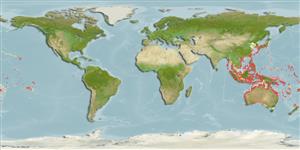>
Elopiformes (Tarpons and tenpounders) >
Elopidae (Tenpounders)
Etymology: Elops: Greek, ellops = a kind of serpent (Ref. 45335).
More on author: Regan.
Environment: milieu / climate zone / depth range / distribution range
بوم شناسي
دريايي; آب شيرين; لب شور; رود کوچ (Ref. 51243); تغييرات عمق 1 - 30 m (Ref. 6898). Tropical; 41°N - 40°S, 92°E - 138°W
Indo-Pacific: from the Andaman Sea in the Eastern Indian Ocean to Western Australia and in the Pacific, from southern Japan to New South Wales and New Caledonia; throughout most of Oceania to the Hawaiian Is., Society Is., and Tuamotus (Ref. 86689). Currently treated as a single species, but this status should be considered provisional. Further studies may reveal a complex of closely related species, as in the case of Albula.
Size / Weight / سن
Maturity: Lm ? range ? - ? cm
Max length : 120 cm SL جنس نر / بدون خواص جنسي; (Ref. 44894); common length : 50.0 cm SL جنس نر / بدون خواص جنسي; (Ref. 10983); بيشينه وزن گزارش شده: 10.1 kg (Ref. 6736)
خارهاي باله پشتي (کل) : 0; شعاع نرم باله پشتي (کل) : 23 - 27; خارهاي باله مخرجي: 0; شعاع نرم باله مخرجي: 14 - 18. A gular plate present between arms of lower jaw. Branchiostegal rays numerous, approximately 20-25. All fins without spines. Scales very small, approximately 100 in lateral line.
A coastal fish, commonly entering lagoon, bays, and estuaries (including fishponds) (Ref. 2847, 58302), particularly around mangroves (Ref. 44894). Sometimes enters freshwater streams, but does not penetrate very far inland (Ref. 2847). Benthopelagic (Ref. 58302). Younger fish often penetrate the lower freshwater reaches of rivers (Ref. 44894). An active swimmer, commonly traveling in schools in open water. Feeds on various fishes and crustaceans. Little detailed knowledge exists of its biology. Has a leptocephalus larva. Spawning takes place offshore and young larvae are found in the open sea, moving close to shore as they develop. Juveniles commonly found in salt marshes, canals, and tidal streams. Marketed fresh or frozen; in some places ground up as fish meal. A good sport fish on light tackle, striking a variety of artificial lures as well as live shrimp or baitfish. No separate statistics available. (Ref. 10983).
Life cycle and mating behavior
بلوغ | تولید مثل | تخم ریزی | تخم ها | Fecundity | توزاد ( لارو)
Smith, D.G., 1997. Elopidae. Ladyfishes, tenpounders. p. 1619-1620. In K.E. Carpenter and V.H. Niem (eds.) FAO species identification guide for fishery purposes. The living marine resources of the WCP. Vol. 3. Batoid fishes, chimaeras and bony fishes part 1 (Elopidae to Linophrynidae). FAO, Rome. (Ref. 10983)
وضعيت در فهرست قرمز IUCN (Ref. 130435: Version 2024-1)
استفاده انسانی
ماهي گيري – شيلات: تجاري; ماهي ها ي سرگرم كننده: بله
ابزارها
گزارش های ويژه
بارگيری XML
منابع اينترنتي
Estimates based on models
Preferred temperature (Ref.
123201): 24.5 - 29.3, mean 28.6 °C (based on 2710 cells).
Phylogenetic diversity index (Ref.
82804): PD
50 = 0.5176 [Uniqueness, from 0.5 = low to 2.0 = high].
Bayesian length-weight: a=0.00589 (0.00258 - 0.01345), b=2.99 (2.79 - 3.19), in cm total length, based on LWR estimates for this (Sub)family-body shape (Ref.
93245).
Trophic level (Ref.
69278): 4.0 ±0.62 se; based on food items.
Fishing Vulnerability (Ref.
59153): Very high vulnerability (88 of 100).
Nutrients (Ref.
124155): Calcium = 77.5 [47.6, 137.7] mg/100g; Iron = 1.11 [0.70, 1.81] mg/100g; Protein = 16.8 [14.3, 19.8] %; Omega3 = 0.162 [0.090, 0.301] g/100g; Selenium = 50.9 [26.7, 100.8] μg/100g; VitaminA = 18.3 [7.4, 44.7] μg/100g; Zinc = 0.994 [0.727, 1.368] mg/100g (wet weight);
